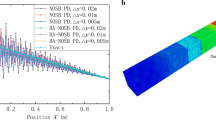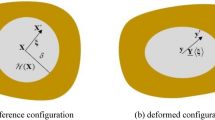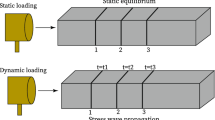Abstract
Peridynamics has unique advantages in solving discontinuity problems such as explosive damage of structures. To further promote the peridynamic models, numerical algorithms and applications, a bond-associated non-ordinary state-based peridynamics (BA-NOSB PD) approach embedded with the Johnson–Holmquist II (JH-2) constitutive is established to analyze the explosive damage and failure of concrete structures. The BA-NOSB PD with the JH-2 constitutive not only can avoid the numerical instability problem, but also can accurately describe the complex mechanical behaviors of quasi-brittle materials such as large strain, high strain rate, and high pressure. The wave propagation and superposition in a concrete bar and the dynamic branch of a rectangular concrete slab are first modeled to display the reliability of the proposed method. Besides, an empirical formula of explosion overpressure is provided to exert the near-field air explosion load. The PD simulation of a reinforced concrete slab under explosion impact captures the typical damage mode well, globally consistent with the actual experiment test. Then, the significance of the influence function on the simulation results is discussed. Finally, the damage process of a concrete gravity dam under explosive loading conditions and the influencing factors such as detonation distance and TNT mass on the damage degree are studied. The simulation results illustrate that the proposed peridynamic approach can accurately and efficiently reproduce the damage and failure process of concrete structures under explosion impact.






















Similar content being viewed by others
Availability of data and material
The manuscript has no associated data.
Code availability
Custom code available when requesting.
References
Tai YS, Chu TL, Hu HT, Wu JY (2011) Dynamic response of a reinforced concrete slab subjected to air blast load. Theor Appl Fract Mech 56(3):140–147
Wang Z, Liang L, Lou J (2015) Analysis on formulas of concrete plate under contact explosion. EPJ Web Conf 94:04057
Li QY, Yu GH, Guo XY (2011) Dynamic response and failure modes of concrete slab under blast load. Appl Mech Mater 94–96:81–85
Hong J, Fang Q, Chen L, Kong X (2017) Numerical predictions of concrete slabs under contact explosion by modified K&C material model. Constr Build Mater 155:1013–1024
Yue S, Qiu Y, Zhang N, Wang M (2017) Analytical study of local damage on concrete slab subjected to a contact explosion. J Vibroeng 19(2):908–929
Wang G (2014) Dynamic response and damage mechanism of concrete gravity dams under extreme loadings. Tianjin University
Linsbauer H (2011) Hazard potential of zones of weakness in gravity dams under impact loading conditions. Front Archit Civ Eng China 5(1):90–97
Chen JY, Lien FS (2018) Simulations for soil explosion and its effects on structures using SPH method. Int J Impact Eng 112:41–51
Ma S, Zhang X, Lian Y, Zhou X (2009) Simulation of high explosive explosion using adaptive material point method. Computr Model Eng Sci 39(2):101
Zhou G (2016) A reproducing kernel particle method framework for modeling failure of structures subjected to blast loadings. University of California, San Diego
Morris JP, Rubin MB, Block GI, Bonner MP (2006) Simulations of fracture and fragmentation of geologic materials using combined FEM/DEM analysis. Int J Impact Eng 33(1–12):463–473
Silling SA (2000) Reformulation of elasticity theory for discontinuities and long-range forces. J Mech Phys Solids 48(1):175–209
Silling SA, Epton M, Weckner O, Xu J, Askari E (2007) Peridynamic states and constitutive modeling. J Elast 88(2):151–184
Javili A, Morasata R, Oterkus E, Oterkus S (2019) Peridynamics review. Math Mech Solids 24(11):3714–3739
Gu X, Zhang Q, Madenci E (2019) Review of peridynamics for multi-physics coupling modeling. Adv Mech 49(1):201910. https://doi.org/10.6052/1000-0992-18-007
Zhou XP, Wang YT (2021) State-of-the-art review on the progressive failure characteristics of geomaterials in peridynamic theory. J Eng Mech 147(1):03120001
Gu X, Zhang Q, Madenci E (2019) Non-ordinary state-based peridynamic simulation of elastoplastic deformation and dynamic cracking of polycrystal. Eng Fract Mech 218:106568
Gu X, Madenci E, Zhang Q (2018) Revisit of non-ordinary state-based peridynamics. Eng Fract Mech 190:31–52
Ren HL, Zhuang XY, Rabczuk T (2017) Dual-horizon peridynamics: A stable solution to varying horizons. Comput Methods Appl Mech Eng 318:762–782
Oterkus E, Guven I, Madenci E (2012) Impact damage assessment by using peridynamic theory. Central Eur J Eng 2(4):523–531
Lee J, Liu W, Hong JW (2016) Impact fracture analysis enhanced by contact of peridynamic and finite element formulations. Int J Impact Eng 87:108–119
Silling SA, Parks ML, Kamm JR, Weckner O, Rassaian M (2017) Modeling shockwaves and impact phenomena with Eulerian peridynamics. Int J Impact Eng 107:47–57
Lai X, Liu L, Li S, Zeleke M, Liu Q, Wang Z (2018) A non-ordinary state-based peridynamics modeling of fractures in quasi-brittle materials. Int J Impact Eng 111:130–146
Kazemi SR (2020) Plastic deformation due to high-velocity impact using ordinary state-based peridynamic theory. Int J Impact Eng 137:103470
Gu X, Zhang Q (2020) A modified conjugated bond-based peridynamic analysis for impact failure of concrete gravity dam. Meccanica 55(3):547–566
Wu L, Huang D, Bobaru F (2021) A reformulated rate-dependent visco-elastic model for dynamic deformation and fracture of PMMA with peridynamics. Int J Impact Eng 149:103791
Wu L, Huang D (2021) Energy dissipation study in impact: from elastic and elastoplastic analysis in Peridynamics. Int J Solids Struct 2021:111279
Huang X, Kong X, Chen Z, Fang Q (2021) Peridynamics modelling of dynamic tensile failure in concrete. Int J Impact Eng 2021:103918
Isiet M, Mišković I, Mišković S (2020) Review of peridynamic modelling of material failure and damage due to impact. Int J Impact Eng 2020:103740
Demmie P, Silling S (2007) An approach to modeling extreme loading of structures using peridynamics. J Mech Mater Struct 2(10):1921–1945
Lai X, Ren B, Fan H, Li S, Wu CT, Regueiro RA, Liu L (2015) Peridynamics simulations of geomaterial fragmentation by impulse loads. Int J Numer Anal Meth Geomech 39(12):1304–1330
Ren B, Fan H, Bergel GL, Regueiro RA, Lai X, Li S (2015) A peridynamics–SPH coupling approach to simulate soil fragmentation induced by shock waves. Comput Mech 55(2):287–302
Fan H, Bergel GL, Li S (2016) A hybrid peridynamics–SPH simulation of soil fragmentation by blast loads of buried explosive. Int J Impact Eng 87:14–27
Fan H, Li S (2011) A Peridynamics-SPH modeling and simulation of blast fragmentation of soil under buried explosive loads. Comput Methods Appl Mech Eng 318:349–381
Diyaroglu C, Oterkus E, Madenci E, Rabczuk T, Siddiq A (2016) Peridynamic modeling of composite laminates under explosive loading. Compos Struct 144:14–23
Wang Q, Wang Y, Zan Y, Lu W, Bai X, Guo J (2018) Peridynamics simulation of the fragmentation of ice cover by blast loads of an underwater explosion. J Mar Sci Technol 23(1):52–66
Zhou XP, Wang YT, Qian QH (2020) Numerical simulations of failure characteristics of rock materials under blasting loads using the conjugated bond-pair-based peridynamics. Sci Sin Phys Mech Astron 50(2):024607
Wang YT, Zhou XP, Kou MM (2019) Three-dimensional numerical study on the failure characteristics of intermittent fissures under compressive-shear loads. Acta Geotech 14(4):1161–1193
Silling SA (2017) Stability of peridynamic correspondence material models and their particle discretizations. Comput Methods Appl Mech Eng 322:42–57
Gu X, Zhang Q, Yu Y (2017) An effective way to control numerical instability of a nonordinary state-based peridynamic elastic model. Math Probl Eng 2017:1
Gu X, Zhang Q, Madenci E, Xia X (2019) Possible causes of numerical oscillations in non-ordinary state-based peridynamics and a bond-associated higher-order stabilized model. Comput Methods Appl Mech Engineering. 357:112592
Yang S, Gu X, Zhang Q, Xia X (2021) Bond-associated non-ordinary state-based peridynamic model for multiple spalling simulation of concrete. Acta Mech Sin 2021:1–32
Madenci E, Dorduncu M, Phan N, Gu X (2019) Weak form of bond-associated non-ordinary state-based peridynamics free of zero energy modes with uniform or non-uniform discretization. Eng Fract Mech 218:106613
Chen HL, Spencer BW (2019) Peridynamic bond-associated correspondence model: stability and convergence properties. Int J Numer Meth Eng 117(6):713–727
Chan W, Chen HL (2021) Peridynamic bond-associated correspondence model: wave dispersion property. Int J Numer Methods Eng 2021:5
Silling SA, Askari E (2005) A meshfree method based on the peridynamic model of solid mechanics. Comput Struct 83(17–18):1526–1535
Johnson GR, Holmquist TJ (1994) An improved computational constitutive model for brittle materials. AIP Conf Proc 309(1):981–984
Xu JX, Liu XL (2008) Full coupled simulation of concrete dams subjected to underwater explosion. J Shanghai Jiaotong Univ (Chin Ed) 42(06):1001–1004
Technical Manual (TM5-1300) (1990) To resist the effect of accidental explosions
Shi Y, Hao H, Li ZX (2007) Numerical simulation of blast wave interaction with structure columns. Shock Waves 17(1–2):113–133
Henrych J, Major R (1979) The dynamics of explosion and its use. Elsevier, Amsterdam
Wu C, Hao H (2005) Modeling of simultaneous ground shock and airblast pressure on nearby structures from surface explosions. Int J Impact Eng 31(6):699–717
Bobaru F, Zhang G (2015) Why do cracks branch? A peridynamic investigation of dynamic brittle fracture. Int J Fract 196(1–2):59–98
Wang W, Zhang D, Lu F, Wang SC, Tang F (2012) Experimental study on scaling the explosion resistance of a one-way square reinforced concrete slab under a close-in blast loading. Int J Impact Eng 49:158–164
Funding
The authors appreciate the financial support from the Fundamental Research Funds for the Central Universities (B200202231, B210201031), and the National Natural Science Foundation of China (Nos. 11932006, 11672101, U1934206, 12002118, 12172121).
Author information
Authors and Affiliations
Contributions
SY: investigation, conceptualization, methodology, visualization, formal analysis, data curation, and writing—original draft; XG: investigation, conceptualization, methodology, data curation, writing—review and editing, and funding; XX: conceptualization, methodology, and results’ discussion; QZ: writing—review and editing, supervising, and funding.
Corresponding author
Ethics declarations
Conflict of interest
No conflict of interest exists in the submission of this manuscript, and the manuscript is approved by all the authors for publication. I would like to declare on behalf of my co-authors that the work described was original research that has not been published previously, and not under consideration for publication elsewhere, in whole or in part. All the authors listed have approved the manuscript that is enclosed.
Additional information
Publisher's Note
Springer Nature remains neutral with regard to jurisdictional claims in published maps and institutional affiliations.
Rights and permissions
About this article
Cite this article
Yang, S., Gu, X., Xia, X. et al. Explosion damage analysis of concrete structure with bond-associated non-ordinary state-based peridynamics. Engineering with Computers 39, 607–624 (2023). https://doi.org/10.1007/s00366-022-01620-x
Received:
Accepted:
Published:
Issue Date:
DOI: https://doi.org/10.1007/s00366-022-01620-x




